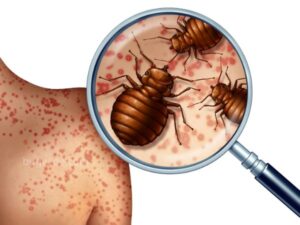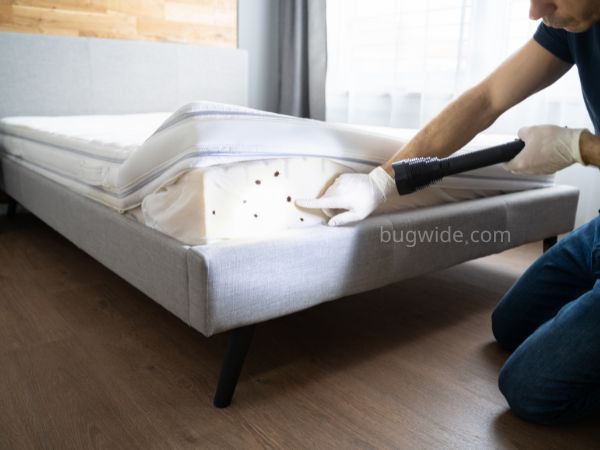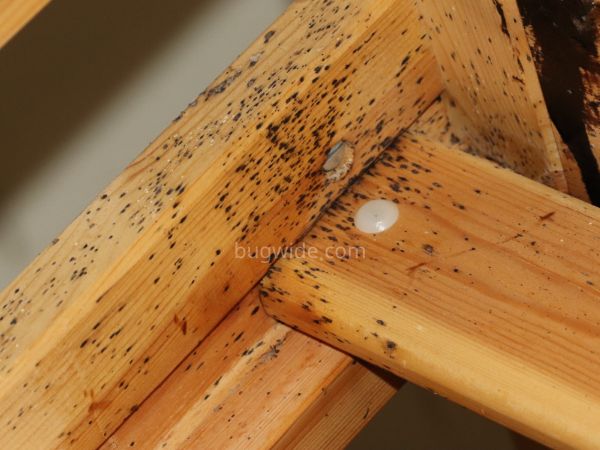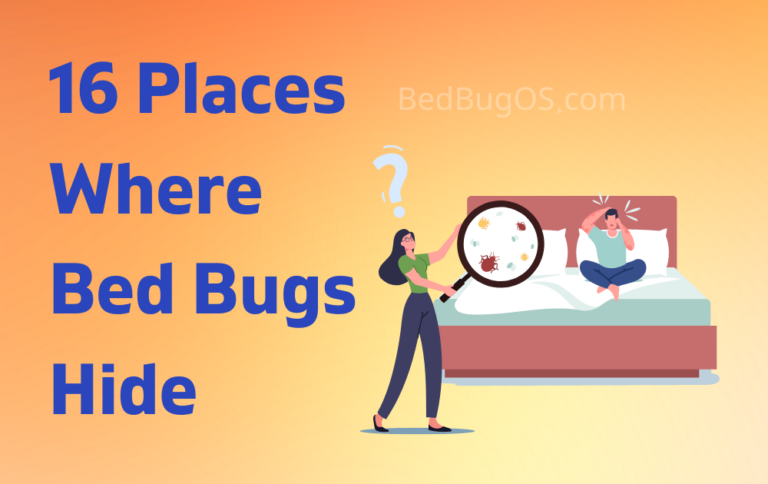How To Find Bed Bugs During The Daytime? [Explained]

Looking for bed bugs during the day can be a challenge. They’re nocturnal creatures, so they’re usually only active at night. But if you know where to look, you can find them during the day, too.
So how do you find bed bugs during the day? Here are a few methods, tips, and tricks listed below, which come from our 10 years of experience as a Bed Bug Exterminator company in Baltimore.
To find bed bugs during the day, start by understanding the signs of an infestation such as blood stains on sheets and tiny black fecal spots. Know their common hiding spots, such as seams of mattresses, behind baseboards, and in the folds of curtains. Use a flashlight for better visibility and inspect all areas thoroughly, paying attention to detail.
Look for physical signs of bed bugs:
The best way to find bed bugs during the day is to look for physical signs of them. These include:
- Small reddish brown spots on your sheets or mattress
- Blood stains on your sheets or mattress
- Dark brown fecal spots on your sheets or mattress
- Egg shells or shed skin from bed bugs
If you see any of these signs, then there is bad news, you have bed bugs.
Check for bed bug bites:

When it comes to bed bug infestations, early detection is key. If you suspect you have bed bugs, one of the first things you should do is check for bites. Bed bug bites can take up to two weeks to appear, so even if you don’t have any visible bites, it doesn’t necessarily mean that you’re in the clear. However, if you do have bites, it’s a strong indication that you may have a bed bug infestation.
To check for bed bug bites, look for a pattern. Bed bugs usually bite several times in a row, creating a line of three or more bites. They also tend to bite in clusters, as they prefer to feed on multiple people at once. By examining the bite pattern, you can confirm whether you are dealing with bed bugs or another type of pest.
Inspect common bed bug hiding spots :
You may have heard that bed bugs are notorious for being hard to find, but did you know that they’re most commonly found in the vicinity of where people sleep? These pesky critters need to feed on human blood to survive, and they’re attracted to the carbon dioxide we exhale while we sleep. That’s why the vast majority of bed bug infestations are located in or around beds.
However, bed bugs can also hide in other places you might not expect. They often take refuge in cracks and crevices near where people sleep, such as in baseboards, headboards, behind pictures, and even in electrical outlets. You might also find them lurking in other furniture, like couches and chairs.
To successfully find bed bugs during the day, it’s important to inspect all potential hiding spots thoroughly. Be on the lookout for any cracks or crevices, as these are prime locations for bed bugs to hide. You’ll also want to keep an eye out for small brown spots on upholstered furniture, as these could be bed bug droppings. By taking a close look at all of these areas, you’ll increase your chances of identifying any bed bugs that might be lurking in your home.
Use a flashlight to look for bed bugs in dark areas:
Bed bugs are nocturnal insects and are most active at night. However, they can also be active during the day if they are disturbed or if they are seeking a food source. If you think you might have bed bugs, it is important to look for them during the day as well as at night with flashlight.

Here are some tips on how to find bed bugs during the day:
- Use a flashlight to look for bed bugs in dark areas. Bed bugs love to hide in cracks and crevices, so be sure to check these areas carefully.
- Look for bed bug fecal matter. Bed bugs leave behind small black spots that can be difficult to see with the naked eye. These spots are actually their faeces and can help you to identify an infestation.
- Check for bloodstains on your sheets or mattress. Bed bugs will bite you during the night and then excrete blood when they return to their hiding place.
- Look for shed bed-bug skins. As bed bugs grow, they shed their skin. These shed skins can be found in their hiding places and can help you to identify an infestation.
- Use a magnifying glass to get a closer look. If you’re trying to find bed bugs during the day, one of the best things you can do is use a magnifying glass. This will help you to get a closer look at any potential bugs and confirm whether or not they are bed bugs.
Be sure to check for bed bugs in all rooms of your home:
To find bed bugs during the day, you’ll need to conduct a thorough search of your home. Check all rooms, including bedrooms, closets, and any other areas where someone might sleep. Look for the telltale signs of bed bugs: small, brownish-red stains on sheets and mattresses; small brown bugs on furniture or in cracks and crevices; and dark-colored spots (about the size of a period) on walls.
Check for bed bugs in hotel rooms before you settle in
If you’re traveling, it’s important to check for bed bugs before you settle in. Look for signs of bed bugs in the room, including blood stains or little black dots on the sheets. You can also check for bed bugs by lifting up the mattress and looking for signs of an infestation. If you see any bed bugs, notify the hotel staff so they can take care of the problem.
Inspect used furniture before bringing it into your home
Bed bugs are most often found in used furniture, bedding, and clothing. If you plan to buy or pick up any used furniture, clothing, or bedding, inspect it carefully for bed bugs before bringing it into your home.

To inspect for bed bugs:
- Look for black spots (fecal matter) or red spots (blood stains) on the fabric.
- Look for small brown bugs crawling on the fabric.
- Look for tiny white eggs glued to the fabric.
- Look for small black egg shells that have been shed by recently hatched bugs.
Where Do Bed Bugs Hide During The Day?
Knowing where bed bugs hide during the day is crucial for effective inspections. They are known for hiding in cracks and crevices, making it essential to look in these areas when searching for them. Here are some common hiding spots:
- Seams of mattresses, box springs, and upholstered furniture
- Behind baseboards, electrical outlets, and light switches
- In the folds of curtains, drapes, and blinds
- Behind pictures and wall hangings
- In the crevices of couches and chairs
FAQ’s
Bed bugs can be found during the day in cracks in walls, behind picture frames, and under furniture.
Here are some things that you can do to prevent bed bugs. Wash your sheets and pillowcases regularly. Use hot water and detergent. Don’t use fabric softener, and don’t wash your clothes in hot water. If you find bed bugs, don’t sleep in the bed, and try to keep your mattress clean.
Yes, you can see bed bugs in the daytime, but it can be challenging as they are small and flat, making them nearly invisible to the naked eye. During the day, bed bugs are usually hiding in cracks and crevices, making it essential to look in these areas when searching for them.
Summing Up:
Finding bed bugs during the day can be challenging, but by understanding the signs of an infestation and where they hide, it’s possible to locate them and take steps to eliminate them from your home. Regular inspections, paying attention to detail, and using a flashlight can all be effective in finding bed bugs during the day. Remember, early detection is key in successfully eradicating bed bugs, so don’t hesitate to take action if you suspect an infestation in your home.

![10 Bugs That Look Like Bed Bugs [Compare With Others]](https://lyssfits.com/wp-content/uploads/2023/01/10-Bugs-That-Look-Like-Bed-Bugs-Dont-Be-Fooled-768x484.jpg)
![10 Tips To Prevent Bringing Bed Bugs Back from a Hotel [Explained]](https://lyssfits.com/wp-content/uploads/2022/12/How-to-Prevent-Bringing-Bed-Bugs-Back-from-a-Hotel_-Revealed-768x484.jpg)
![16 Reasons : Why Would Bed Bugs Be In The Bathroom ? [Explained]](https://lyssfits.com/wp-content/uploads/2022/12/16-Reasons-Why-Would-Bed-Bugs-Be-In-The-Bathroom-Explained-768x484.jpg)

![Does Rubbing Alcohol Kill Bed Bugs? [Explained]](https://lyssfits.com/wp-content/uploads/2023/07/Does-Alcohol-kill-bed-bugs-768x483.png)
![Where Do Bed Bugs Come From? [Revealed]](https://lyssfits.com/wp-content/uploads/2022/12/Where-do-bed-bugs-come-from_Revealed-768x484.jpg)